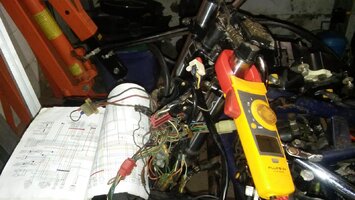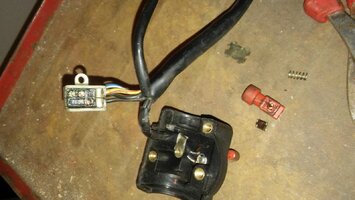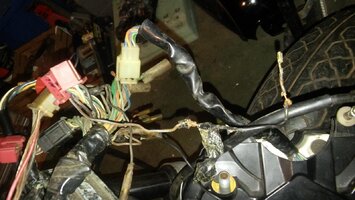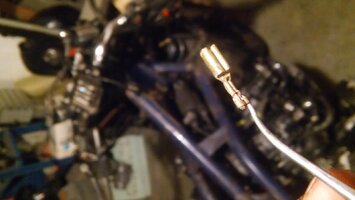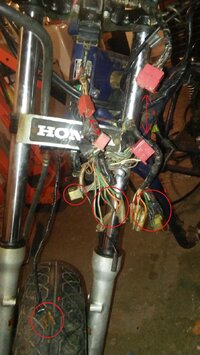Motorcycles are spit simple compared to a modern electronically controlled car............once you start communicating in canbus part-to-part and sending responses in pulse width modulation it gets plenty crazy.
LOL, can bus communication and pulse width modulated replies...love it! Reminds me of the diode lasers of the pumping unit

So....I have made some progress but this project will surely take some focus. So I have successfully installed the motor in the frame and connected a battery to the system. I do not have an ignition key also, so I disconnected the connector at the ignition switch and installed a jumper wire between the red and black wires. (more on this later)
Connected the short ground wire to the frame and battery. Short red wire between solenoid and + to the battery. The solenoid harness is connected and all the harness are connected at the front of the motorcycle. Think all that is not connected are the spark plugs, head light, rear light harness and blinkers. Rest seems connected, including instrument cluster, neutral safety switch and clutch switch.
One thing I notice is that when I connect the battery, NO sparking occurs. usually when I connect a battery to a vehicle, the circuit completion usually generates some energy or sparks. There is NO sparking or signs of life in this system.
When I try the start switch, nothing happens. If I short the starter solenoid, the starter does crank. Cleaned the heck out the gummed up start switch. (it was heavily corroded) Did a continuity test on the switch and the switch and circuit work properly yet the bike will not crank via the switch. No instrument cluster lights neither. One last observation is that if I keep the positive probe across the positive terminal of the battery, and probe nearly every connector in the harness, I measure 12V nearly everywhere. Does this indicate my harness is potentially shorted? I notice if I move the positive lead of my multi meter across other circuits that I think should have voltage, I tend to measure 0.
I know voltage is the difference in electrical potential between two points, so one point must be + and the other - for a voltage reading to occur. Also 0 Ohms is an ideal resistance as opposed to lets say two connecting points measuring 300 ohms for example.
So hopefully some of you gurus can give me some multi meter measurements of voltage or resistance that I can perform on each component starting at the battery and moving one component at a time along the schematic.
I have multiple color schematics also
